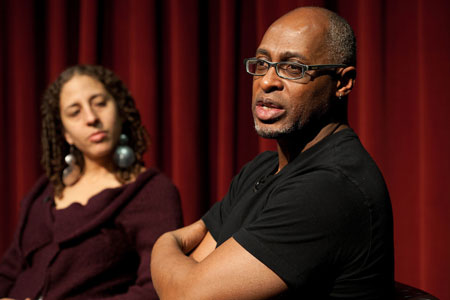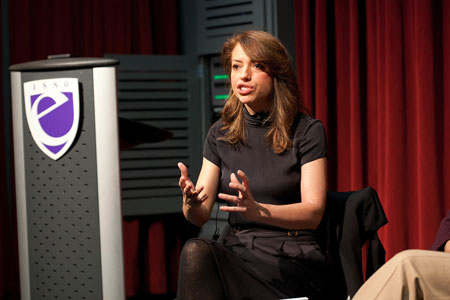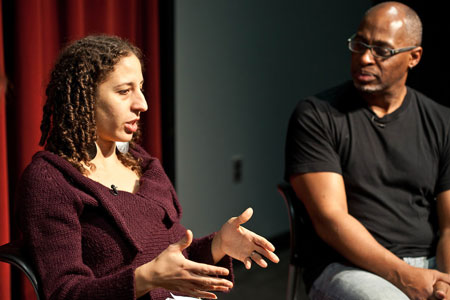Journalists discuss 2014 civil rights coverage

What are the civil rights stories the media are covering—or not covering well enough—in 2014?
In a discussion at Emerson on February 13, prominent Boston journalists Farrah Stockman of the Boston Globe and Phillip Martin of WGBH singled out the rights of prisoners and immigrants as issues the news media could do a better job of spotlighting.
“Prison rights is a big deal and we’re failing on that,” Stockman said. “[It’s something] people don’t talk much about. We have a huge prison population in our country and they remain largely a hidden story.”
Stockman and Martin participated in the 90-minute discussion at the Max Mutchnick Campus Center with Cindy Rodriguez, journalist-in-residence in the Journalism Department. The talk was one of several events at Emerson this month recognizing 60 years of civil rights progress.

“We have a new type of Jim Crow in this country represented by the prison industrial complex,” Martin said. “Part of the media’s failure, and that includes myself, of course, is [to] grasp that as a complex, as an industry, [the prison system is] something that is self-perpetuating.”
“Should we be paying a lot closer attention to this high school-to-prison pipeline?” Martin asked. “The answer is yes.”
Another widely recognized civil rights issue today is the advancement of LGTBQ rights.
“Lesbian, gay, bisexual, and transsexual issues are a big deal,” Stockman said. “To some extent, the media has covered them well. That’s why we’re having so much change happen so quickly.”

Martin said immigration is another important civil rights issue facing journalists—and one that needs improvement in its coverage.
“Talking about immigration devoid of history is really problematic,” he said.
Stockman said the immigration issue is “so salient” because “it’s about our identity and what it means to be an American.”
“It’s also an issue of human rights,” Martin said. “The assumption that sometimes is implicit in how we cover stories is that some people, in terms of their identity, are less than others.
“I think if we were talking about European immigration, we would personify and give voice to individuals—not just [use] this whole group dynamic,” he said. “We see Mexicans as this mass of individuals rather than delving into the intricacies of who those individuals are.”
Stockman and Martin discussed other parallels of media coverage of social issues today versus 60 years ago, when the movement for racial equality was in full swing.
“We had racially segregated newspapers 50 to 100 years ago,” Stockman said. “Today we have politically segregated newspapers.”
Martin made comparisons with the recent Occupy movement. Both Martin and Stockman said activists and social media were a huge reason the movement got so much coverage.
“It’s hard for a journalist to start from scratch,” Stockman said. “We should pay more attention to activists we feel are important, but they also have to be responsible.”
“Occupy is the very reason we now use terms like ‘the 99 percent,’” Martin said.
Martin added that the best way for young journalists to understand the value of information from activists and social media is to be “on the ground” in their communities as much as possible—in order to stay in tune with what’s happening.
Categories